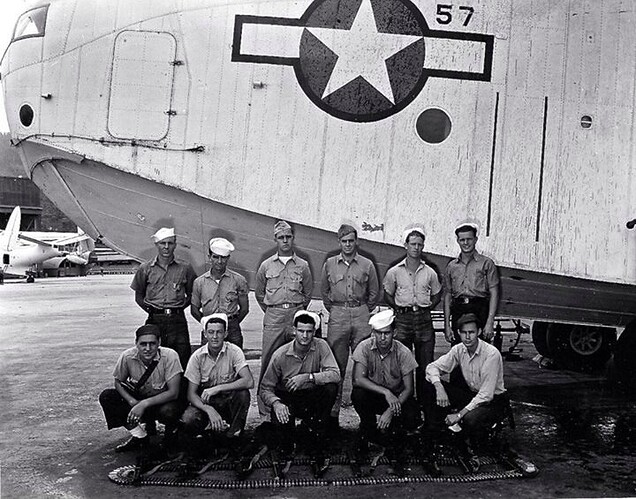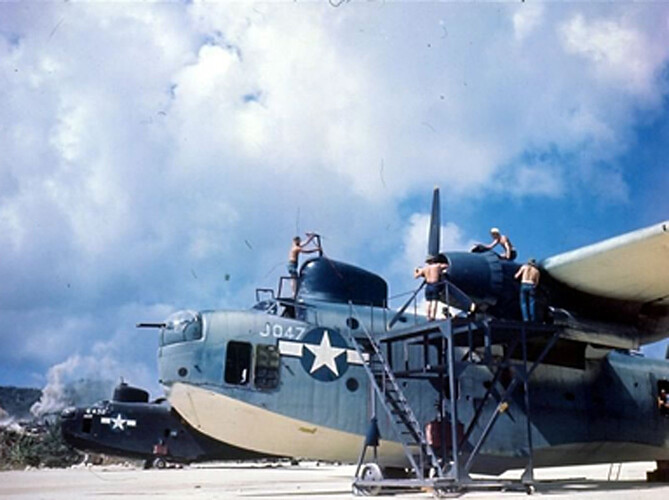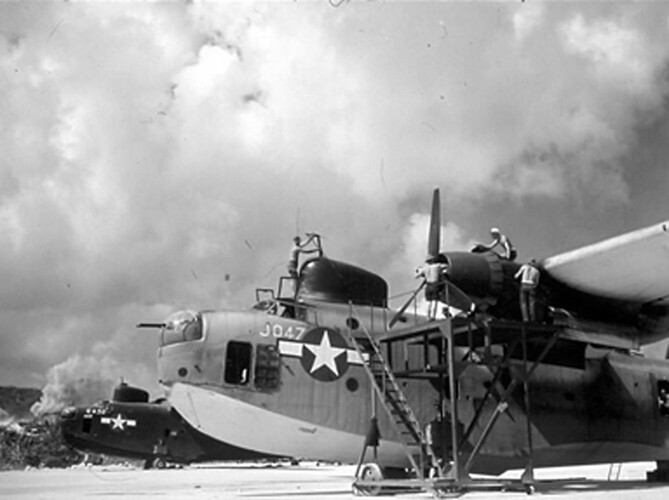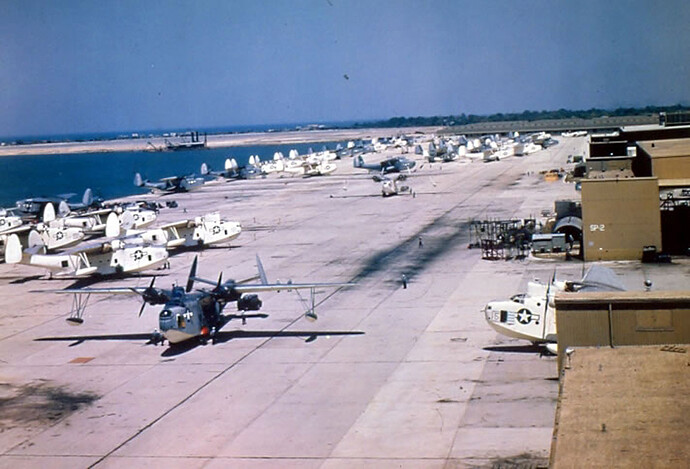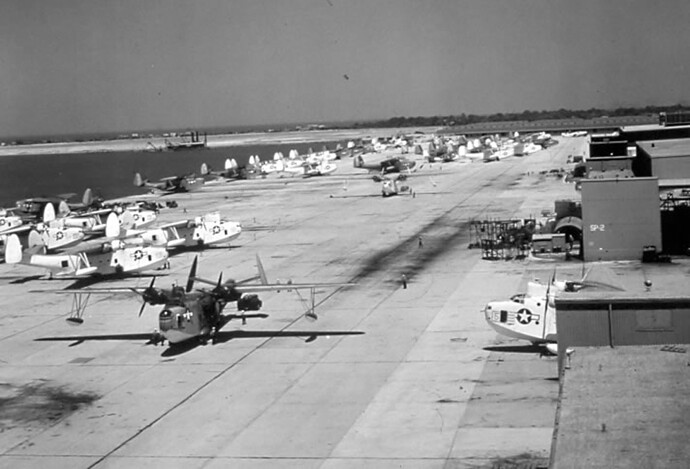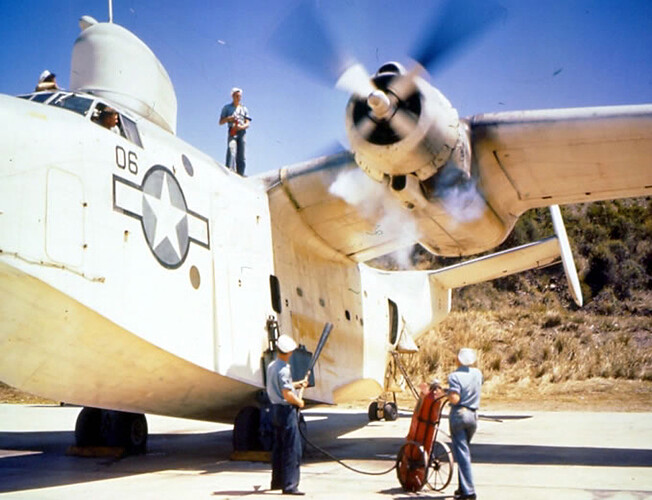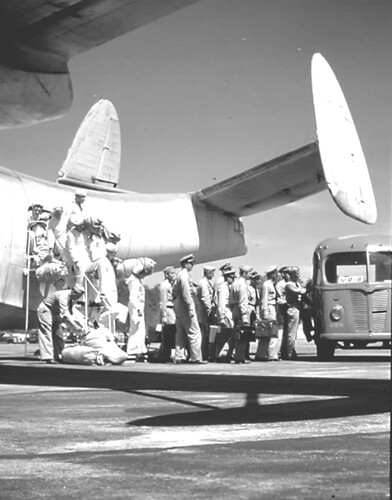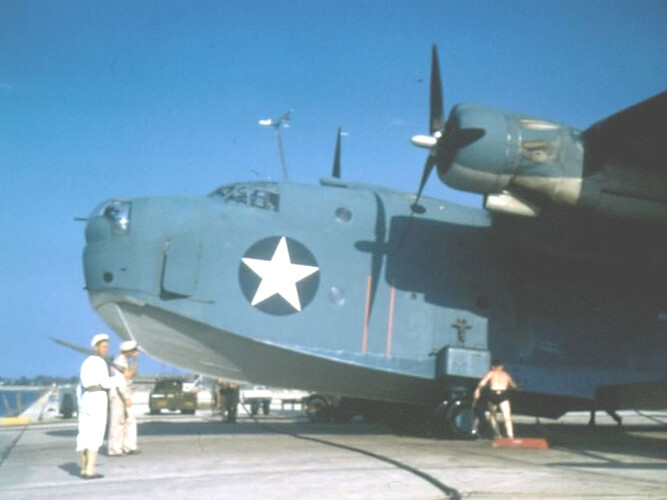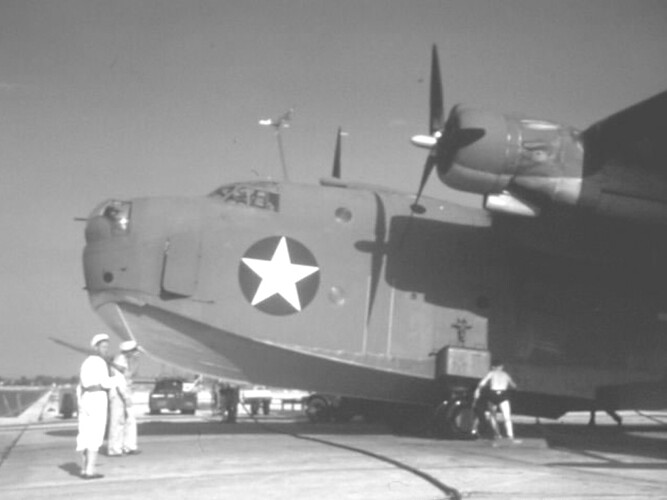My grandfather was the navigator for this plane and that is about all I know. He never talked about the war so any and all information would be greatly appreciated. I also have a picture of the cockpit if that would help. Thanks Lisa.
Hi Lisamedic
PBY Catalina Patrol Bomber.
See second picture down.
http://thesabaislander.com/2014/01/08/aviation-over-our-islands-during-world-war-ii/.
is Your Grandfather in this photo.
Chunky
Ummm, most certainly NOT a PBY Catalina. That is a PBM Mariner.
Later . . . off hand, I’d say it was a PBM-3. Also, if you look in the background you can see another . . . the PBM tail structure is quite distinctive.
Unfortunately, there’s not enough in the photo to identify a place or squadron. I’d guess, though, from the apparent light color of the airplanes we can see that this is somewhere in the Atlantic theater. I could probably come up with a list of PBM squadrons operating in the Atlantic, but that would be just what it would be, a list.
Hi R Leonard
I did after putting down PBY Catalina a ?, but deleted it:army:
It was the bit of the front canopy in the photo, that confused me, it would have had a mechanism to move the front gun-turret up and down, which I could not see in the photo, that being said, I had just came home from a 4 hour, with driving, A.T.C civilian chairman Meeting, so my eyes were a bit dim :oops:. The photo its self, it could have been taken at Pearl Harbor.
Please accept my apologies Lisa, if I have given you the wrong information on the plane.
Chunky
No, I don’t believe the locale is Pearl Harbor; wrong colors for Pearl Harbor.
Squadrons assigned to the Pacific theater, including the continental west coast, were painted in non-spec blue grey over light grey (and a very few towards the end of the war in overall dark blue).
Squadrons operating patrols in the Atlantic theater were, generally, a light grey, sometimes even so light as to appear white, overall with upper wing surfaces and tops of fuselage a dark grey, sometimes more, often times less. Certainly it was not at all unusual to see the blue-grey over light grey scheme in Atlantic regions, but the overall light grey/white scheme was reserved for squadrons in the Atlantic and was not used in the Pacific. The photo clearly shows the aircraft in question and the one parked behind it in the light grey/white scheme.
Hi Leonard,
Agree. It is a PBM-3, by going a bit further I would say PBM-3R, the un-armed version, as I cannot see the trademark twin guns in the nose (although that spot is at the edge of the pic).
I would take a wild guess, about that 57 near the USN Air Wing badge.
Although by my info VP-931 (later designated VP-57) were established after WW2 and saw action in the Korean War.
Lisa, upload pls. the cockpit pic. By any chance your father took part also in the Korean War?
I was sorely tempted to go with a -3R designation but held off because of all that belted .50 cal. ammunition draped at their feet. Not all PBMs, besides the -3Rs, had the forward twin ball turret.
I believe that the aircraft in the VP rons operating during Korea were, by then, all overall dark blue and the national insignia would have the red bar within the white.
I’ll gin up a list of Atlantic VP/VPB rons operating PBMs today & check on their use in WW2 VR rons.
yep, right about the colors…sorry not so much familiar with US insignia.
Would be interesting to see a list of all these US squadrons flying missions on the Atlantic theatre to spoil the wurst & sauerkraut lunch of Herr Doenitz. Especially nice to know the operating bases. PM if too long to post here.
Should be started a separate thread (if not already) about the USAF/USN Airforce in Atlantic against German high seas shipping? It is a topic little known or discussed.
Not taken away from what your saying, but I would say, if the photo was taken say in the shade, or taken in bright sunlight, this would have a effect the photo, taken this into account, you can’t really get a good idea of what the colour is, looking at what I can see of the plane, its flown a few missions by the look of it, a good wash down, and a bit of touch-up, and it would look a lot better. This not not taken away from the fact, that they were Brave men.
And exactly just who said they were not? And if the answer is “no one” then why raise the subject?
No offense, but that’s just a lot of imagination and wishful thinking. The photos are more than clear.
How do you know if the plane had indeed flown a lot of missions, training missions, out of VP-2 OTU in Jacksonville, Florida, day in and day out from April 1941 (that being from when the first production batch was complete) to the end of the, oh, say, July 1945? Would it not look equally used?
Why do we need to imagine something that the picture clearly does not show?
Golly, and I well remember when USN planes were dark blue all over.
A quick and dirty list of PBM equipped VP/VPB squadrons in the Atlantic operating areas during the war is below. This list does not include PBMs attached to the VP/VPB OTU stations for crew training.
VP-16
VP-17
VP-18
VP-21
VP-22
VP-25
VP-26
VP-27
VP-28
VPB-28 (VP-28 redesignated 1 Oct 44)
VP-32
VPB-32 (VP-32 redesignated 1 Oct 44)
VP-74
VPB-91
VP-201
VPB-201(VP-201 redesignated 1 Oct 44)
VP-202
VP-203
VPB-203 (VP-203 redesignated 1 Oct 44)
VP-204
VPB-204 (VP-204 redesignated 1 Oct 44)
VP-205
VPB-205 (VP-205 redesignated 1 Oct 44)
VP-206
VPB-206 (VP-206 redesignated 1 Oct 44)
VP-207
VPB-207 (VP-207 redesignated 1 Oct 44)
VP-208
VPB-208 (VP-208 redesignated 1 Oct 44)
VP-209
VPB-209 (VP-209 redesignated 1 Oct 44)
VP-210
VPB-210 (VPB-210 redesignated 1 Oct 44)
VP-211
VPB-211 (VP-211 redesignated 1 Oct 44)
VP-212
VPB-212 (VP-212 redesignated 1 Oct 44)
VP-213
VPB-213 (VP-213 redesignated 1 Oct 44)
VP-214
VPB-214 (VP-214 redesignated 1 Oct 44)
VP-215
VPB-215 (VP-215 redesignated 1 Oct 44)
VP-216
Regarding PBM-3R’s used by NATS and others, just breezing through weekly aircraft location reports –
I see there were PBM-3R’s assigned, for example in August 1944, to VR-2 (ComNATSPac), VR-6 and VR-8 (ComNATSLant). PAAPac also operated -3Rs out of Honolulu under the ComNATSPac umbrella. Complements noted in the returns were 26, 14, 17 and 10, respectively, a total 67 of which leaves some head scratching as that’s more than a third again as many -3Rs than were produced or converted from other -3 types . . . hmmmm.
Picking another report at random, in November 1944, in the Pacific, VR-2 operated 8 -3Rs between Honolulu and Alameda; VR-10 had 10 at Honolulu for maintenance; PAAPac had 10 based at Honolulu; HedRon2, 10 at Kaneohe; HedRon8, 11 at Alameda and VH-2 reported 6, also at Kaneohe. In Atlantic climes, VR-6 had 8 at Dinner Key; VR-8, 11 at Patuxent; HedRon3, 1 at Coco Solo; HedRon11, 3 at San Juan; HedRon12, 2 at Key West. At 80, totaled, that’s more than 1.6 times the number ever in service. It would appear that there might be a lot of double counting going on between Oahu and California. Someone at BuAer should have caught that.
Skipping ahead another three months to February 1945, VR-2 has 2 of the -3Rs at Alameda; VR-6, 12 at Dinner Key; VR-10, 10 for maintenance at Honolulu; and PAA Pac, 1 at Honolulu. Looks like -3Rs are being pressed into patrol/rescue units as they appear in the inventories of squadrons such as VH-3 with 4 at Saipan; VH-4, 6 at Honolulu and VH-5, 4 at Alameda. They also appear in the inventories of a couple of FAW HedRons on the Atlantic side, such as HedRon3, 1, and HedRon11, 2, and on the on Pacific side, such as HedRon8 with 11 at Alameda. That’s still 4 more than production and conversions, and I know that by February of 1945 at least two -3Rs had been lost in flight accidents, one in February of 1943 and another in June 1944. Still another sank in a taxiing accident, but I don’t have a date for that.
A big jump ahead to the end of July 1945, in the Pacific, Hedron2 has 2 -3Rs at Kaneohe; VPB-100, 1 at Kaneohe; VH-5, 3 at Majuro, 1 at Perry Island and 3 at Ebeye; and VH-1, 6 at Saipan. In the Atlantic, HedRon3 had 1 at Coco Solo; HedRon11, 1 at San Juan. None appear in the NATS VR ron’s reported inventories. There were 49 -3Rs produced, depending how you count, so, where did the rest go by August 1945? Except for the three known losses, probably converted back to one of the other -3 versions (remember that 31 of the -3R’s were conversions from other -3 versions, so these might be more like re-conversions), or they could have assigned to an OTU (which are not included in the location reports), or parked somewhere as pool aircraft and insufficiently identified to count. The 18 total of this count matches the actual new, non-conversion, production of the -3R.
I don’t believe the number 57 over the national insignia is significant as a squadron identifier; generally the practice of explicit putting squadron identifying numbers on planes was pretty much a no-no after early 1942. Certainly letter codes were used to identify training activities, and fleet & light carriers used geometric design identifiers, and later at the end of the war, letter identifiers; CVEs by 1945 were using a complicated for the uninitiated carrier division identifier system of stripes, area painting, and colors. But, bottom line, is that one would not see a squadron identifier such as the number we see in the picture.
The more I look at the photo, the more it appears to be of a PBM assigned to one of the VP OTU squadrons. In the OTU’s newly minted aviators, the pilots, were married up with a crew and they all trained together for eventual assignment, together, to an operating squadron. Some of the period photos I’ve seen of planes assigned to the OTU’s show similar numbering in the same placement near the national insignia. I’d further note that, again, generally, and unlike the USAAF, navigators, even bombardiers, in the USN WWII VP community were more often than not enlisted as opposed to officers.
I’m really more up on carrier type aircraft as my field of interest, but I can muddle my way through US naval aviation, generally, to include patrol operations.
And as an aside, yes, there were also a plethora of PBY and PB4Y squadrons as well as the PBM squadrons operating over the Atlantic. They did, indeed, sometimes make a nuisance of themselves for the unwary submarine.
Just a list of PBM squadrons, their stationing, and relative dates exceeds the permissible message length. Let me work on stripping out all the Pacific operations and I’ll PM you. Excel okay?
I used the words “Brave men” because I made a light-hearted mention, on the plane needing a good wash and a bit of touch up.
I’m pointing out, that photos taken in direct sunlight, of an object, then the same object taken in shade, will effect the image/object considerably.
I would have to answer you question, by asking you a question, how could you tell it do hasn’t flown many missions, missions/training missions, would, I would say, put the same wear and tear, IE, salt water/ climate, on the fuselage. This is not taken into account any battle damage.
“A picture is worth a thousand words.” - Napoleon Bonaparte
I used the words “Brave men” because I made a light-hearted mention, on the plane needing a good wash and a bit of touch up.
I’m pointing out, that photos taken in direct sunlight, of an object, then the same object taken in shade, will effect the image/object considerably.
I would have to answer you question, by asking you a question, how could you tell it do hasn’t flown many missions, missions/training missions, would, I would say, put the same wear and tear, IE, salt water/ climate, on the fuselage. This is not taken into account any battle damage.
“A picture is worth a thousand words.” - Napoleon Bonaparte
All clear Leo. Thanks. I will take some time to read all this nice info. PM xls is ok for me. Thanks for the hard work.
But we should not forget the initial target of the thread. We should dig more on it…tough nut to crack though.
You might want read a little more carefully, I never said the PBM in the picture was pristine or was not very well used; obviously it had been used, and repeatedly over a period of time. What I am saying is, that regardless of any opinion on lighting and camera angle, the photo in question is not, as you seemed to wish or explain away, at Pearl Harbor. That is easily discernible from the manner in which the plane is painted. A little investigation of WW2 USN practices in painting their aircraft might help clarify the issue for you. Digressions into mission frequency are beside the point.
You might want to also look into “a picture is worth a thousand words” a little bit  before crediting old Nappy. Being careful to use a UK source just to be fair, see, among others:
before crediting old Nappy. Being careful to use a UK source just to be fair, see, among others:
http://www.phrases.org.uk/meanings/a-picture-is-worth-a-thousand-words.html
Note the lead sentence “This phrase emerged in the USA in the early part of the 20th century.”
My QUOTE; it could have been taken at Pearl, not as your saying, QUOTE; not, as you seemed to wish or explain away, at Pearl HarborQUOTE, as for the painting, as your saying "practices, they were painted as to where they were used, as there is no colour in this photo, it could be, it could be;), that there was no colour photography at this time. you can only surmise on what is the actual colour.
I’ll stick with QUOTE; Napoleon Bonaparte, I liked him:evil:
Well, I suppose now I must certainly bow to your demonstrated superior knowledge of USN paint practices . . . did I mention that these “practices,” a word to which you apparently take some exception, were published directives from the USN Bureau of Aeronautics? . . . as in “you will do this.” I suppose also it would be asking far, far too much to ask you to point us all in the direction of true enlightenment as you seem to know something the rest of the USN at the time did not.
Be that as it may, you are obviously far more knowledgeable then am I on the subject . . . and your ability to tell darkening of blue from a lightening of, if you will, not blue, in a clearly composed black and white photo is positively uncanny , especially with the myriad of available image examples a simple google or bing search might present.
So, if you wish to believe that the photo in question actually shows an airplane painted blue only we cannot see that it is so, you just go on believing that . . . someday it might even be true . . .
I do not recommend holding your breath until that day comes.
Bye the bye, there most certainly was color photography in the 1940s . . . maybe something else you might wish research . . . of course, I could be wrong and you, again, right.
I love consistency.
Each to their corners now,  Color still photography was available (though not generally) from the mid 1930’s. As to military photography, it was most commonly done in B/W, color print work being reserved for special occasions, or when technically necessary. Not all military photo labs were equipped to print color negatives, as that is a more technically demanding process. Transparencies were able to be processed at nearly any lab, as no printing was needed.
Color still photography was available (though not generally) from the mid 1930’s. As to military photography, it was most commonly done in B/W, color print work being reserved for special occasions, or when technically necessary. Not all military photo labs were equipped to print color negatives, as that is a more technically demanding process. Transparencies were able to be processed at nearly any lab, as no printing was needed.
I can tell you that attempting to discern a color from the Gray scale is not easy at all, as several different colors may have a matching gray scale. (This is why Frankenstein’s Monster is rendered in color with green skin in posters, they needed to differentiate between Boris’s face, and other elements in the scene when shot in B/W. Showing as different shades of gray.
No point in trying to figure the colors involved here, much too difficult to do.
So, just so I understand the problem . . .
Here’s a nice (OMG) color shot on a nice sunny day on Eniwetok in 1945 . . . there’s two PBMs in the shot, the one in the background merely serves to show that by the end of the war the overall dark blue regulation was in play in the VPB community. The one in the front is the one of interest . . . typical of most of the war for the Pacific Theater, the regulation non-spec blue grey over light grey.
Now, what happens when we see the same scene in black and white? Don’t know how this works for anyone else, but I can sure discern the blue grey from the light grey.
Let’s try again. Here’s the seaplane ramp at Norfolk NAS (a place, apropos of nothing else I spent many an hour in my youth drowning bait or dipping crabs) where we see at least 30 PBMs in both the regulation north Atlantic grey top over white sides and not a few of what one might think more standard blue-grey over light grey. Another nice sunny day.
First color
Now black & white - is it really that hard to tell one scheme from the other? And can anyone besides me make out the difference between the blue grey and the light grey on the PBM facing us in the foreground? Even though the light grey is totally in shadow? Who would have thought!
Now, let’s head south to Guantanamo Bay NAS. Here’s a nice shot of a PBM in the north Atlantic scheme. Note the white fuselage and the dark grey on the top of the fuselage, the radar dome and leading edges of the wing. If you were to look down on the plane from directly above, the entire upper wing surface would be that dark grey. You can see that in the photo above of the ramp at Norfolk NAS. And another bright sunny day.
Same deal, first color -
Next B & W - note nice solid color to the fuselage, but you can still see the edges of the grey upper works.
But wait, there’s more . . .
How about a quick trip back north, this to Patuxent River NAS (another place I’ve spent a little time, there’s some great cliffs near by with fossils of shark teeth three and four inches long just falling out of them) for a picture of an actual PBM-3R from VR-8.
Nice color shot on a nice summer day . . . again with the north Atlantic scheme. You can make out the dark grey in all the right places.
And now B & W - certainly no confusion in my mind about the paint scheme in use.
Last but not least here’s a nice color shot of a blue-grey Pacific standard scheme. Yet another lovely day (I’m beginning to suspect no one took color pictures in bad weather  ). The light grey underside is partly in the shadows and partly in the sun.
). The light grey underside is partly in the shadows and partly in the sun.
So, what happens with B & W? Is it too hard to tell where the blue-grey ends and the light grey begins? Well, not for me, with or without my glasses. And the difference in appearance between a blue-grey over light grey scheme and a overall white/light grey with dark grey upper surfaces scheme is fairly obvious to me, indeed, stark when comparing this photo to the PBM at Guantanamo Bay, above.
Guess I just do not understand the problem.
Beautiful pic’s, thanks R.

